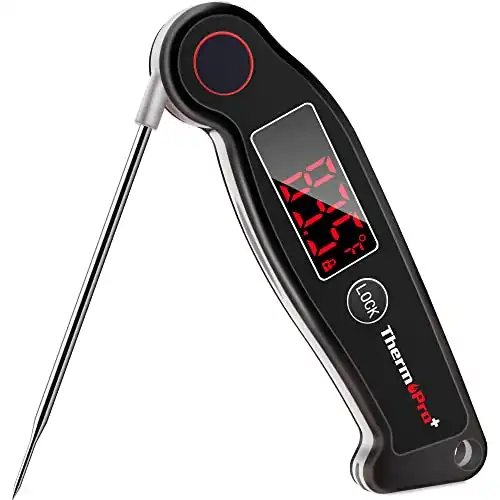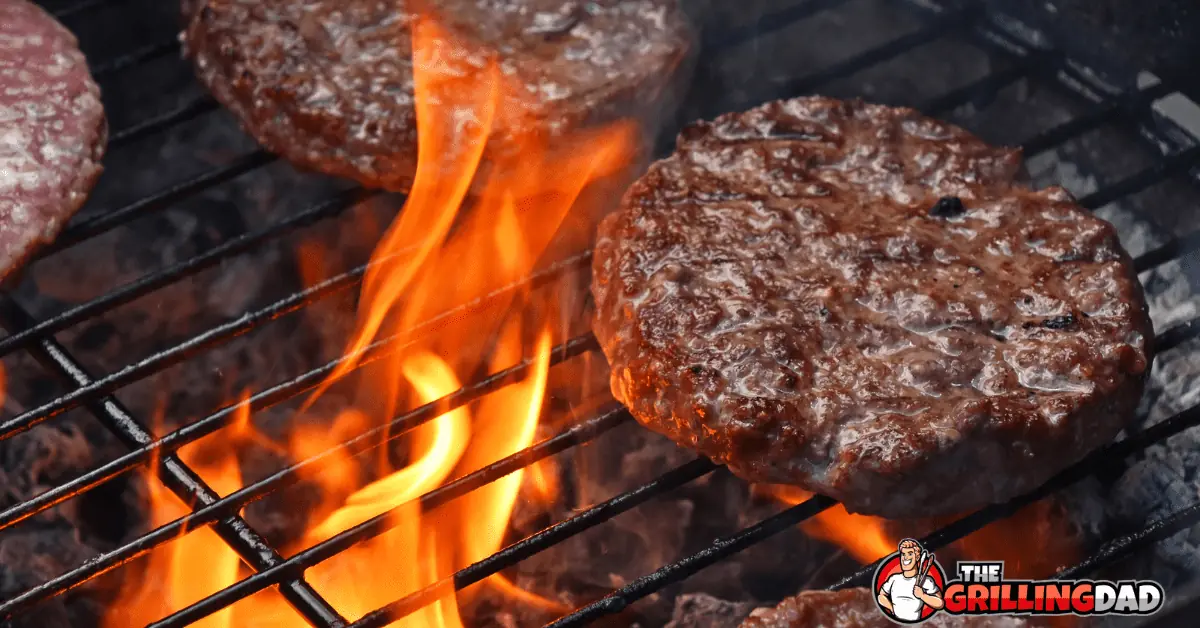The quest for the perfect brisket is a noble pursuit, filled with smoky twists and turns. But when it comes to nailing that tender, juicy goodness, knowing the ideal brisket internal temp is the key to unlocking BBQ perfection. Although anything between 190°F and 203°F is considered to be in the “sweet spot”, TheGrillingDad considers 195°F to be the perfect internal temperature for brisket, here’s why.
Jump to Section
What is the Best Internal Temperature for Brisket?
Brisket is a popular choice at barbecues and family cookouts. It’s one of the toughest types of cow meat, so slow cooking, and smoking brisket is the best way to go for the ultimate results.
Perfecting your brisket entails a crispy and smoky exterior with a juicy center. When you get this right, you’ve officially become a barbecue master. The secret is all in achieving the best brisket internal temp.
The best internal temperature for brisket is 195°F. Keep in mind that the temp can continue to rise by up to 10° after you pull it from the smoker and you want to avoid overcooked, tough brisket.
What Internal Temp Means Brisket is Done?
Typically, a brisket is considered done when it reaches an internal temperature between 190°F and 203°F. This range is often referred to as the “sweet spot” for a perfectly cooked brisket. It’s important to note, however, that each brisket is unique, and the ideal internal temperature may vary based on personal preference and the specific qualities of the meat.
Achieving the desired internal temperature is a marriage of both patience and skill. As the brisket cooks, collagen, a connective tissue in the meat, begins to break down, rendering the brisket tender and flavorful. The higher the internal temperature, the more collagen will be broken down, resulting in the melt-in-your-mouth texture we all strive to get. However, exceeding the optimal internal temperature can lead to a dry and overcooked brisket, robbing it of its juiciness and tenderness.
The Best Brisket Internal Temp: 195°F
Although there are plenty of factors to consider, we recommend reaching 195°F for your brisket’s internal temp, but, as mentioned, anywhere between 190°F and 203° will get you great results.
Cooking the beef until it reaches this brisket internal temp makes for tender and juicy meat with the right spring and consistency. Undercooking or overcooking it will make it tough and hard to chew.
Patience is your best friend when cooking brisket. As mentioned, slow cooking is the way to go to achieve the perfect tenderness and texture.
You want to smoke the meat with indirect heat so that the collagen melts and turns into that melt-in-your-mouth texture.
Related >> Corned Beef vs. Brisket: What’s the Difference?
Why Should Briskets be Cooked to 195°F?
Different people with different smokers and tastes will have varying opinions on the best temp for brisket.
Lots of barbecue masters and enthusiasts agree that there isn’t a one-size-fits-all answer to the question of what temp is brisket done. That’s because it largely depends on the exact type and weight of meat as well as the cooking methods used.
Some believe that an internal temperature of 180°F is the ideal temp and anything above 210°F is overcooked.
Conversely, others suggest that the conversion of collagen to gelatin happens efficiently near the 212°F mark.
While some will say that 203°F is better, it might not produce meat that’s tender enough for everyone.
We found that 195°F is the ideal middle ground for beginners.
There will be times, though, when you might want to remove the meat earlier or later.
This is particularly true if you’ve noticed that the brisket cooked quicker than expected. When this happens, it’s better to use the probe, poke, and tug tests to check if it is done in real-time.
How Long Does it Take to Cook Brisket?
Waiting for your brisket to reach 195°F might seem like it’s taking forever! In general, if you are smoking your brisket at 225°F, you should expect it to take 1.5 hours per pound of brisket. This means for an 8lb brisket, you could be looking at a 12-hour cook time!
How to Check Your Brisket’s Internal Temperature
Checking the internal temperature of a brisket is a crucial step in ensuring it reaches the desired level of doneness. To accurately measure the internal temperature, you’ll need a reliable meat thermometer.
Begin by inserting the thermometer probe into the thickest part of the brisket, making sure to avoid touching any bones as this can affect the reading. Take care not to push the probe all the way through to the other side of the meat. For the most accurate results, aim to position the probe towards the center of the brisket.
Allow the thermometer a few seconds to stabilize and then take note of the reading. To ensure consistency, it’s a good practice to check the temperature at multiple spots throughout the brisket. This will help account for any variations in temperature and ensure the entire brisket is cooked evenly.
Remember, the internal temperature of a perfectly cooked brisket typically falls between 190°F and 203°F. By following these steps and monitoring the internal temperature, you’ll be able to achieve a beautifully cooked brisket with flavors that are tender, juicy, and just right.
Is the Internal Temp the Best Way to Know When The Brisket is Done?
While checking the internal temperature certainly gives us the key information needed to determine the doneness of brisket, it may not necessarily be considered the absolute best method on its own. Evaluating a brisket’s doneness involves considering multiple factors to achieve the perfect result. While internal temperature provides a helpful guideline, relying solely on it might not yield the most accurate outcome.
The texture of the meat, visual cues, and understanding of the cooking process all play significant roles. Texture, for instance, should be tender yet not mushy, with the meat yielding slightly to gentle pressure. Visual cues such as a well-developed bark, rendered fat, and a distinct smoke ring can also indicate proper cooking. Additionally, the cooking process includes the “stall” phase, where the internal temperature may plateau or drop slightly as collagen breaks down, leading to enhanced tenderness and juiciness.
While the internal temperature remains an essential aspect, considering texture, visual cues, and the cooking process can provide a more reliable assessment of when a brisket is truly done to perfection.
Other Ways to Tell If Your Brisket is Done
Wondering if your brisket is ready to be pulled off the smoker? Here are just a few ways in which you can tell!
Probe Test
The probe test entails the use of a probe, knife, or toothpick to confirm if the brisket is cooked in the middle. If it slides in/out easily, the meat should be done. The lack of resistance should be similar to slicing soft butter.
The biggest disadvantage of this method is that doing too many tests will dilute the meat’s flavor because inserting probes will let the heat and juices out.
Poke Test
The poke test has the same premise. You can insert a fork into the meat and twist it around. Again, if you find that it twists without much resistance, that means the brisket is ready.
Tug Test
The tug test is where you cut off a thin slice of the brisket and hold each end in your left and right hands. If the meat tears right away, the brisket is done cooking.
However, all of these methods entail opening the smoker to check the meat’s doneness. This can release heat and disturb the cooking process, which is a bad thing if your brisket isn’t done cooking yet.
The most reliable method is still using meat thermometers or probes to measure the temperature.
This way, you won’t have to keep opening and closing the smoker, which makes the entire process more convenient.
What Happens If Brisket is Undercooked?
Because brisket is beef, it is technically safe to consume it at a lower temperature than 195°F. The problem is, the connective tissue in brisket won’t have broken down yet at lower temperatures.
This means if you undercook a brisket and try to serve it, it’s likely to be tough and inedible. It may also be chewy and overall unpleasant to eat. We don’t recommend undercooking brisket.
What Happens if You Overcook Brisket?
Just as undercooked brisket is unappetizing, overcooked brisket can be just as bad.
Overcooked brisket is dry and while it will fall apart easily, it is likely to be unpleasant to eat. For best results, you should plan to cook your brisket to no more than 210°F. (We recommend pulling it out at 195°F and letting it rest to reach the final temperature).
Why Does the Temperature of My Brisket Stop Rising?
It can sometimes feel like torture trying to get your brisket to 195°F, especially when the temperature stops rising.
The reason your brisket temperature has stopped rising is that it has reached a phase called the stall. This usually happens between 150°F-170°F and this is normal. Leave your brisket in the smoker and eventually, it will again begin increasing in temperature, it just takes time.
You can combat the stall by wrapping your brisket in butcher paper or aluminum foil. Alternatively, you can just wait patiently for the stall to pass.
Why Do Different Pitmasters Recommend a Different Brisket Temperature?
The truth is, every brisket is different, and every pit master has their own preferred way of cooking and serving their brisket.
For best results, you should ask someone whose brisket you’ve tasted (and enjoyed) for the temperature they cook theirs too. You should also ask what weight of briskets they use as this will also make a difference in cooking styles and methods.
If you’ve never had a brisket you loved, then try cooking your brisket to 195°F, you won’t regret it!
Tips for Smoking Brisket
Monitoring the internal temp of your brisket is just one of the factors to be mindful of.
Here are other things to ensure you get a deliciously smoked brisket:
- Patience is key
- Place thermometers properly
- Keep the cooker humid
- Practice until you master it
Patience is Key
As mentioned, slow cooking is the best approach to enjoy this meat cut. Great things take time, and that includes your home-cooked brisket.
It can take as much as 18 hours to cook a full packer and reach the desired internal temp of 195°F.
That’s because it will take about 1.5 hours per pound to get the doneness right.
Make sure to cook the brisket low and slow. Wrapping it in the middle of the process or basting it beforehand can help the meat retain moisture and prevent dryness, especially on the exterior.
Place Thermometers Properly
To ensure accurate internal temperature readings, you must know the best spots to insert the thermometer.
It should be positioned flat in the brisket and inserted from the side rather than the top.
The tool should also be placed into the thickest part of the meat rather than the fat since these portions cook at different rates.
Some grills and smokers have two cooking probes, which allow you to monitor the temperature for the flat and point of the meat.
Keep the Cooker Humid
Don’t forget to place an aluminum pan with water beneath the cooking grate of your cooker.
With this, you can keep the smoking environment humid, which is crucial for slowing down evaporation, collagen breakdown, and fat rendering.
As a result, these processes can occur at the same pace. A moist atmosphere inside the smoker also preserves the natural tacky texture on the meat’s surface, which can boost smoke penetration.
Practice Until You Master It
You might not get the brisket texture, doneness, and flavor you want right off the bat. But, don’t be dismayed.
As a beginner, you still have a lot to learn in terms of experience in grilling the best home-cooked brisket for you and your family.
As mentioned, there are plenty of factors to consider, from the weight and cut of the meat to the type of smoker you have.
Don’t give up and continue to practice the craft until you master it.
Just like any other advanced recipe, it takes time to master barbecuing the brisket. Nonetheless, the results are well worth it once you’ve perfected the process.
How to Smoke a Full Packer Brisket
A brisket with both the point and the flat is referred to as a full packer.
Packers can weigh between 10 to 20 pounds before trimming. A particularly large full-packer brisket can take up to 18 hours to smoke.
To cook a full packer, you should remove excess fluids by draining and drying them with towels.
Next, chill it in the fridge to prepare for trimming. Removing fat becomes easier when the meat is chilled as opposed to cutting soft and slippery fat.
Some people enjoy lots of fat on their brisket, while others opt to trim it. If you’re trimming the fat cap, cut it into a uniform thickness, about 1/4” thick.
Make sure to trim off large “nodules” or chunks of fat.
Pay particular attention to the silverskin as well since it won’t break down during the cooking process. It’s the thin membrane that covers the brisket’s exposed side, which is opposite the fatty side.
Dry rub the brisket with a mixture of salt and pepper. The traditional recipe entails a simple ratio of one part kosher salt and one part pepper. A full packer will use up between 3/4 to one cup of the rub.
While you can add spices according to your preferences, try to keep things as simple as possible to focus on the inherent flavors of the meat.
Apply the dry rub and let it sit for a few hours. You can also marinate the meat overnight for better flavor.
If you keep the brisket chilled in the fridge, take it out an hour before cooking at room temperature.
Use this waiting window to preheat your smoker by starting a fire and adding wood.
We recommend using oak if you’re looking for the right smoky flavor without overpowering the meat. It also burns cleanly and consistently, which makes it ideal for slow cooking.
At this stage, you can also insert the temperature probes along with the meat.
If you have different probes for cooking and air, insert the former into the thickest part of the flat, while the air probe should be placed on the grate between the meat and the grill’s edge.
If you’re wondering whether you should place the meat fat side up or fat side down, you should get to know your cooker.
Some smokers have more top heat than bottom heat, while others emit more heat at the bottom.
You want the brisket’s fat to render before the lean side gets overdone, so check the level of heat your cooker releases on each side.
For air probe alarms, these should be set at 225°F (low) and 275°F (high).
This way, you get alerted if the temperature gets too low or high during the smoking process. Use the air vents to adjust the temperature in the pit.
Suppose you want to remove the meat and wrap it in the middle of the cooking process. In this case, the cooking probe alarm should be set at 150 F (high).
As such, you’ll know when you can open the smoker and remove the brisket. Make sure to close the lid again to keep the heat inside.
Don’t forget to use gloves and tongs when handling the hot meat.
Prepare the paper in advance and wrap the brisket in two layers of peach paper or unlined butcher’s paper.
Pitmasters wrap meat to prevent it from losing moisture and drying out. It’s also useful for delaying the further darkening of the exterior, especially if the cooking process goes quicker than anticipated.
Place the wrapped meat back in the smoker and reset the cooking probe alarm to 203 F (high).
Conversely, you can set the cooking probe alarm at 203 F (high) at the start if you don’t plan on wrapping the brisket.
Resume cooking until the highest internal temperature is reached.
Once it’s there, you can remove it from the grill, and the temp will continue to rise to the ideal brisket’s internal temp of 195°F as it rests.
Remember, the vent’s smoke should be thin and blue. If it’s thick and white, the wood you’re using may be damp and can evoke a bitter flavor in the meat. If this happens, increase ventilation to burn the wood quickly and replace it with dry ones.
Full Recipe >> Texas Style Smoked Brisket Recipe
Is Smoked Brisket Healthy?
Surprisingly, some say that brisket may actually be good for your health. Scientists at Texas A&M AgriLife Research found that the cut has higher levels of oleic acid than the flank or plate. In turn, this increases levels of high-density lipoprotein (HDL), more commonly known as “good” cholesterol.
The fat in brisket cuts is also a crucial component of beef. Moreover, it has a low melting point, which makes slow-cooked brisket so juicy. It’s also why people like barbecuing it.






